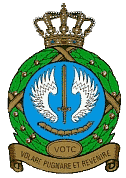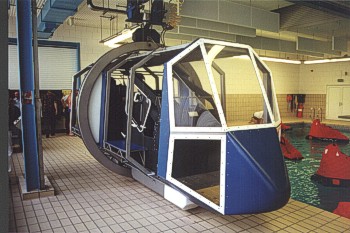History
Established in 1957, the Vliegveiligheids-, Oefen- en
Testcentrum (Flight safety, Practice and Test Center)
started it first course at Soesterberg Airbase. The
primary objective of this center was to drill pilots in
the use of their flight safety equipment. Secondary the
center advised in the making of regulations, books,
manuals and the testing of new equipment.
After a couple of moves, the VOTC found it's home at
Gilze-Rijen Airbase in the Netherlands were Flightgear
On-line visited the center.
Present
The VOTC teaches all airmen (pilots, technical crew,
attendants, rescue swimmers and others) in the use of the
available flight safety equipment on their aircraft. Also
the skill of surviving in an hostile environment is
trained. The courses given at the VOTC are:
|
 |
-
Initial
Combat survival Course (4 to 5 weeks)
-
Refreshment
Course
-
Dinghy
Drill (also on sea)
-
Parasailing
-
Conversion
Course
-
HUET
(Helicopter Underwater Egress Training)
-
CSAR
(Combat Search and Rescue)
-
Theater
Update Briefing (Bosnia, Italy, Cambodia)
-
And
tailor made courses on request.
The
center also evaluate, test and develop flight safety equipment
for airmen. The center advises the Airforce on acquisition
and/or replacement of this gear. The testing takes place in
actual operational conditions. For instance the testing of new
gloves and a new type of snow saw in Canada (minus 40 Celsius)
and the testing of new flight coveralls at squadron level. The
VOTC is also involved in (crash) accident investigation were a
piece of flight safety equipment was used. Also advice and
training is offered to the Police Air wing, (NLR) Dutch Flight
Laboratory and on special request.

HUET
One of the main "attractions" at the VOTC is the
heated swimming pool. This multipurpose indoor pool can be used
at daytime for night simulation also. Aircrews are trained her
to use their flotation devices (dinghy, life preserver) and how
to escape from a ditched helicopter (Egress). The center has 5
instructors who are licensed divers and they keep a sharp
lookout while a class is using the pool. The egress training is
carried out with the HUET (Helicopter Underwater Egress Trainer)
and SWET (Shallow Water Egress Trainer). The HUET device can be
modified to simulate the layout of different helicopter types.
The SWET is used on the initial training only. The crew learns
to escape from, for instance, the hulk of a Cougar transport
helicopter. On our visit the HUET was equipped as the Apache
attack helicopter. When the crew is strapped in, the HUET is
lowered into the water and can be inverted (what usually happens
with ditched helicopters). Doors and escape hatches can be
jammed to make things even more difficult. Try to imagine
yourself in the dark, in cold water, strapped in an upside down
helicopter with the emergency door you want to use blocked….
One of the most useful items in this scenario is the HEED
bottle. This breathing device gives the user a valuable three
minutes of spare oxygen. The crew also learns to survive in cold
water. Most people would try to swim to keep warm. It is a fact
however, that floating in a folded up manner without moving
keeps you alive longer. During Flightgear On-line's
visit, some fresh PC-7 student pilots were practicing basic use
of their life preserver and dinghy. Getting in your dinghy with
inflated LPU-3 Bananas under your arms turned out to be not so
easy. It also showed us an alternative way of using your flying
helmet. An HGU-55/P is very useful as a bucket to empty your
water filled raft…

Gear
For their courses, the VOTC has a very large stock of gear.
Helmets in use are mostly former HGU-26/P's converted to
HGU-55/P types. Oxygen masks are used and rejected MBU-12/P
examples without communications. Most redundant flightgear
(damaged, lifetime expired) is send to the center from
operational units. In there inventory the center has a.o.
coveralls, g-pants, helmets, masks, life preservers, dinghy's,
parachutes, torso harnesses, survival vests and items, soft
packs and even door slides from the KDC-10 tanker aircraft. In
the main building some classrooms can be found. The exhibition
room is in fact a large hall were different environments are
life size displayed. These environments include a.o. desert,
snow and woodland theatres. Two Egress cockpits are available
(F-16 and PC-7) and a mockup fuselage part of a KDC-10 is also
in use for door training. Outside the facilities some examples
of survival shelters can be found. They are made by using
natural materials like trees and branches.
Sea drill
Besides pool training, the VOTC also supplies sea drills. This
is making it the only Royal Netherlands Airforce unit to operate
a boat. For sea drill pilots are parasailed behind a speedboat.
While disconnecting from the boat, they have to inflate their
LPU's and drop their seat pack. On impact in the water, the
parachute has to be released (manually or by sea/u-wars). The
pilot then has to board his dinghy and try to contact a SAR
helicopter. The SAR helicopter drops a rescue swimmer and both
are winched up. This marks the end of their course and making
them Combat Ready.

Flightgear On-line likes to thank the men and women at
the VOTC for their help. More information on this subject can be
found at the VOTC's website, just follow the link.
Source: Royal
Netherlands Airforce VOTC
|